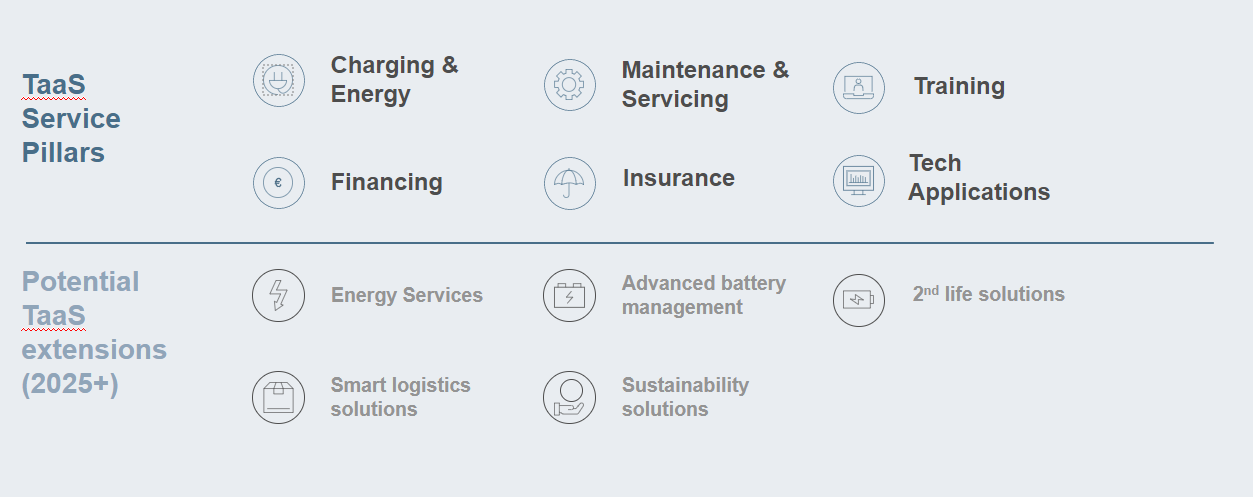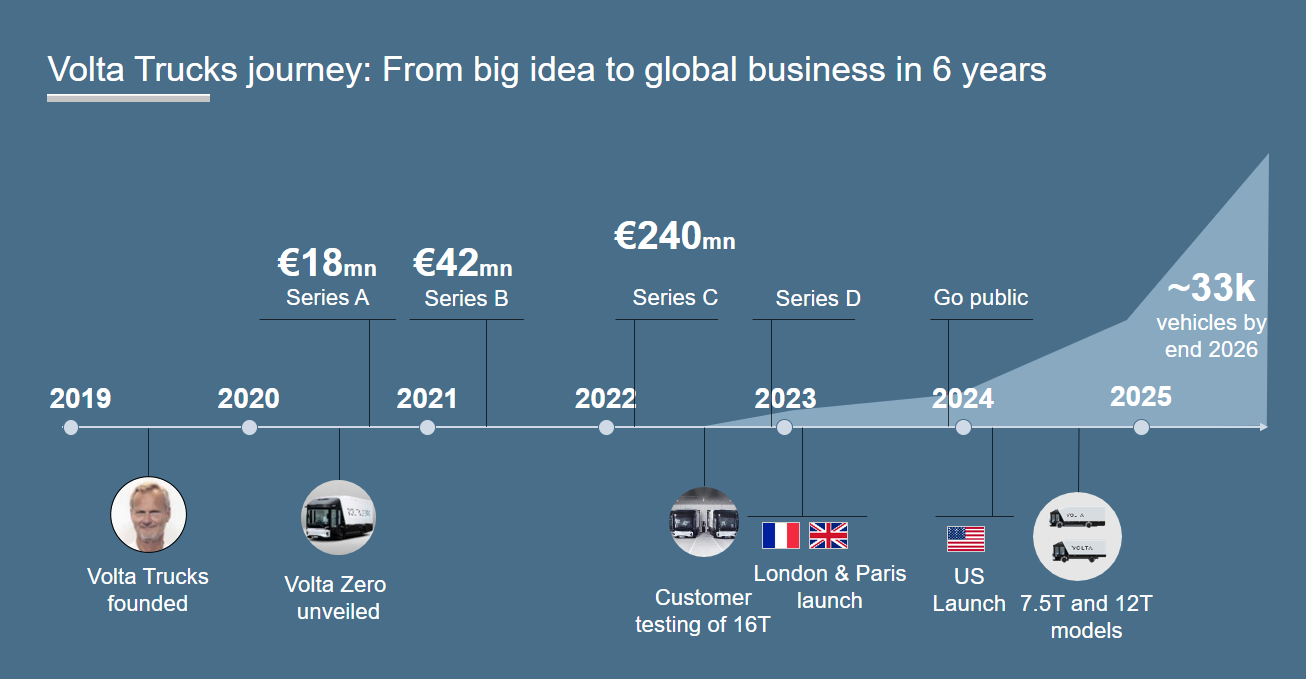< Back to insights
Published 09. Jun. 2022
Carl-Magnus Norden: From Idea to Global Business in Just 6 Years
The journey from an idea to a company that is growing at an industry-leading pace is not easy. However, several business examples show how it can be done, including Volta Trucks which manufactures and provides service for zero-emissions commercial trucks.
Founder Carl-Magnus Norden started investigating the concept behind the Volta Trucks in 2016 and is now on track to go public with the company in 2023. He takes us through this journey and shares his strategy for the organization’s success in our recent 90Minutes Insights webinar on the future of electric vehicles.
Identifying and Addressing Problems
Volta Trucks’ approach is to provide Trucks as a Service (TaaS), an innovation to accelerate the transition to zero-emissions commercial trucks and reduce customer complexity and risk.
The growing appeal of electric vehicles (EVs) indicated that the market is ripe for such an innovation. Wanting to address three main issues of climate change, road safety, and driver shortage that is sweeping Europe and the United States, Norden came up with the idea for Volta Trucks.
Norden emphasized the importance of listening to Volta Truck’s potential customers to identify the issues and the best ways to address them – which is the core of the company’s strategy right from the beginning.
He said, “When you start a venture like we have done, I think It’s very important, number one, like we have done from day one, to talk to the customers, listen to their problems.”
Norden recounted his discussions with Transport for London which illuminated the scale of the road safety issue that the city was facing. According to Transport for London, while only 4% of traffic in the city are trucks, they are involved in 78% of all fatal accidents with bikers and about 26% with pedestrians. This is a major issue that requires an effective and innovative solution which Volta Trucks wants to address.
As for the driver shortage issue, Volta Trucks focused on the truck design itself using a “driver-centric” approach. A standard diesel truck is built in such a way that drivers are sat quite high up in the cab. Climbing in and out of a commercial truck over 20 times per day can be frustrating for many drivers, leading to them simply jumping out of the cab instead, Mr. Norden found. This results in many of them developing issues with their knees, hips, and joints.
They are also sat on one side of the cab, meaning that they can only exit the truck on one side, which may pose safety risks when coming out on the side of traffic, creating blind spots. It also poses a risk for other road users.
Coming with a “driver-centric” approach, the design by Volta Trucks starts with an electric drive train as a base, with the motor on the rear axle and the battery housed within the ladder frame. This allowed for full freedom to create a cab design that optimized for driver comfort and safety.
Design features also include much bigger windows to minimize blind spots; a center seat for the driver allowing for exits on either side and 220-degree vision; and sliding doors to avoid risks to oncoming traffic.
Sharp Focus is the Key to Success
The key to Volta Trucks’ success in going from an idea to a global business was a sharp focus on its mission, according to Norden.
One example of this sharp focus is Volta Trucks scope of producing only electric trucks. This means they only have one drive train technology to master, enabling the company to develop at a pace that many incumbents or existing marketplaces cannot.
They also only manufacture mid-duty trucks at between 7.5 to 18 tons, leaving out long-haul trucks or small delivery vans. Further, Volta Trucks only offers two cargo box types: refrigerated and ambient. Their market research shows that this opens them up to at least 60% of the biggest cities in Europe.
This level of focus led Volta Trucks to narrow its focus on city distribution with depots placed in the outskirts of cities, thus allowing Volta Trucks’ zero-emissions vehicles to go around the city making deliveries all day and come back to the depot in the evening.
“The beauty of that is that they are stationary in the night. More or less, we know how long they are driving, and we can do the charging infrastructure around it. We don’t have to rely on public charging infrastructure. We install it at the depots,” Norden explained.
To date, Volta Trucks have procured a location for a service center in Paris, with plans to open more centers in London and Madrid. They are setting up wide-reaching capabilities around maintenance services, charging infrastructure as well as finance and fleet management.
From Big Idea to Big Business
In the passenger car market, Tesla has 75% of the market share in EVs in the US – with the remaining 25% being other major car manufacturers like Volkswagen and Mercedes. In the commercial vehicle world, Volta Trucks is making waves and growing rapidly.
Norden attributed the company’s ability to outpace its competition because it started entirely from scratch. Volta Trucks created the opportunity for itself to not only come up with an innovative product but the services around it as well.
Importantly, the company is not limited by legacy designs or organization. They are not held back by legacy business models. This allows Volta Trucks to start with a clean sheet and construct a business model, organization, and systems that are adaptable and tailor-made to its use case.
“When it comes to strategy, …we tried to have a very simple and clear strategy. We have reimagined the urban truck, we are moving at speed and scale, and focus on sustainability and safety,” Norden noted.
Volta Trucks is not a research project. Instead, it has jumped straight in with the intention to hit the market at volume with its product as soon as possible by leveraging proven, market-ready technology. They “look for people that know their business”. This strategy is applied across Volta Trucks’ supply chain.
For example, Norden worked with US-based Proterra for its batteries as the company has over a decade of experience working with electric buses and major commercial vehicles. For the motor and E-axle, Volta Trucks partnered with Meritor, one of the biggest axle manufacturers in the world.
Even in manufacturing, they have partnered with the existing manufacturing site for MAN Truck & Bus. As MAN ramps down, Volta Trucks is ramping up, allowing for plenty of room to expand.
Norden stressed: “You have to work very closely with all your stakeholders, I would say, and that has been our attitude from the beginning.”
“With the whole ecosystem, we have to work together. So in our case, we will have been talking to customers from day one, getting their input about design and other things. The same thing with our supply chain.”
“There is a lot of good developments out there. But we need to do it together.”
Sign up now: Become a member of Aurora Live Executive Business Network, to enjoy free access to the CxO Insights webinar series, exclusive networking opportunities, and more.



